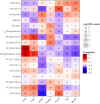Indolepropionic acid and novel lipid metabolites are associated with a lower risk of type 2 diabetes in the Finnish Diabetes Prevention Study
- PMID: 28397877
- PMCID: PMC5387722
- DOI: 10.1038/srep46337
Indolepropionic acid and novel lipid metabolites are associated with a lower risk of type 2 diabetes in the Finnish Diabetes Prevention Study
Abstract
Wide-scale profiling technologies including metabolomics broaden the possibility of novel discoveries related to the pathogenesis of type 2 diabetes (T2D). By applying non-targeted metabolomics approach, we investigated here whether serum metabolite profile predicts T2D in a well-characterized study population with impaired glucose tolerance by examining two groups of individuals who took part in the Finnish Diabetes Prevention Study (DPS); those who either early developed T2D (n = 96) or did not convert to T2D within the 15-year follow-up (n = 104). Several novel metabolites were associated with lower likelihood of developing T2D, including indole and lipid related metabolites. Higher indolepropionic acid was associated with reduced likelihood of T2D in the DPS. Interestingly, in those who remained free of T2D, indolepropionic acid and various lipid species were associated with better insulin secretion and sensitivity, respectively. Furthermore, these metabolites were negatively correlated with low-grade inflammation. We replicated the association between indolepropionic acid and T2D risk in one Finnish and one Swedish population. We suggest that indolepropionic acid, a gut microbiota-produced metabolite, is a potential biomarker for the development of T2D that may mediate its protective effect by preservation of β-cell function. Novel lipid metabolites associated with T2D may exert their effects partly through enhancing insulin sensitivity.
Conflict of interest statement
The authors declare no competing financial interests.
Figures





Similar articles
-
Associations of serum indolepropionic acid, a gut microbiota metabolite, with type 2 diabetes and low-grade inflammation in high-risk individuals.Nutr Diabetes. 2018 May 25;8(1):35. doi: 10.1038/s41387-018-0046-9. Nutr Diabetes. 2018. PMID: 29795366 Free PMC article. Clinical Trial.
-
Diabetes and branched-chain amino acids: What is the link?J Diabetes. 2018 May;10(5):350-352. doi: 10.1111/1753-0407.12645. Epub 2018 Feb 13. J Diabetes. 2018. PMID: 29369529
-
Markers of cholesterol metabolism as biomarkers in predicting diabetes in the Finnish Diabetes Prevention Study.Nutr Metab Cardiovasc Dis. 2015 Jul;25(7):635-42. doi: 10.1016/j.numecd.2015.03.012. Epub 2015 Mar 28. Nutr Metab Cardiovasc Dis. 2015. PMID: 25921846 Clinical Trial.
-
Metabolomics of Type 1 and Type 2 Diabetes.Int J Mol Sci. 2019 May 18;20(10):2467. doi: 10.3390/ijms20102467. Int J Mol Sci. 2019. PMID: 31109071 Free PMC article. Review.
-
Indolepropionic Acid, a Gut Bacteria-Produced Tryptophan Metabolite and the Risk of Type 2 Diabetes and Non-Alcoholic Fatty Liver Disease.Nutrients. 2022 Nov 6;14(21):4695. doi: 10.3390/nu14214695. Nutrients. 2022. PMID: 36364957 Free PMC article. Review.
Cited by
-
Gut microbial metabolic signatures in diabetes mellitus and potential preventive and therapeutic applications.Gut Microbes. 2024 Jan-Dec;16(1):2401654. doi: 10.1080/19490976.2024.2401654. Epub 2024 Oct 18. Gut Microbes. 2024. PMID: 39420751 Free PMC article. Review.
-
Metabolomics-based biomarkers of fermented dairy and red meat intake: a randomized controlled trial in healthy adults.Front Chem. 2024 Sep 24;12:1461331. doi: 10.3389/fchem.2024.1461331. eCollection 2024. Front Chem. 2024. PMID: 39380951 Free PMC article.
-
The butyrate-producing and spore-forming bacterial genus Coprococcus as a potential biomarker for neurological disorders.Gut Microbiome (Camb). 2023 Aug 30;4:e16. doi: 10.1017/gmb.2023.14. eCollection 2023. Gut Microbiome (Camb). 2023. PMID: 39295905 Free PMC article. Review.
-
The complex link between the gut microbiome and obesity-associated metabolic disorders: Mechanisms and therapeutic opportunities.Heliyon. 2024 Sep 7;10(17):e37609. doi: 10.1016/j.heliyon.2024.e37609. eCollection 2024 Sep 15. Heliyon. 2024. PMID: 39290267 Free PMC article. Review.
-
Interactions between Gut Microbiota and Natural Bioactive Polysaccharides in Metabolic Diseases: Review.Nutrients. 2024 Aug 24;16(17):2838. doi: 10.3390/nu16172838. Nutrients. 2024. PMID: 39275156 Free PMC article. Review.
References
-
- Hanhineva K. et al.. Nontargeted metabolite profiling discriminates diet-specific biomarkers for consumption of whole grains, fatty fish, and bilberries in a randomized controlled trial. J. Nutr. 145, 7–17 (2015). - PubMed
Publication types
MeSH terms
Substances
LinkOut - more resources
Full Text Sources
Other Literature Sources
Medical

